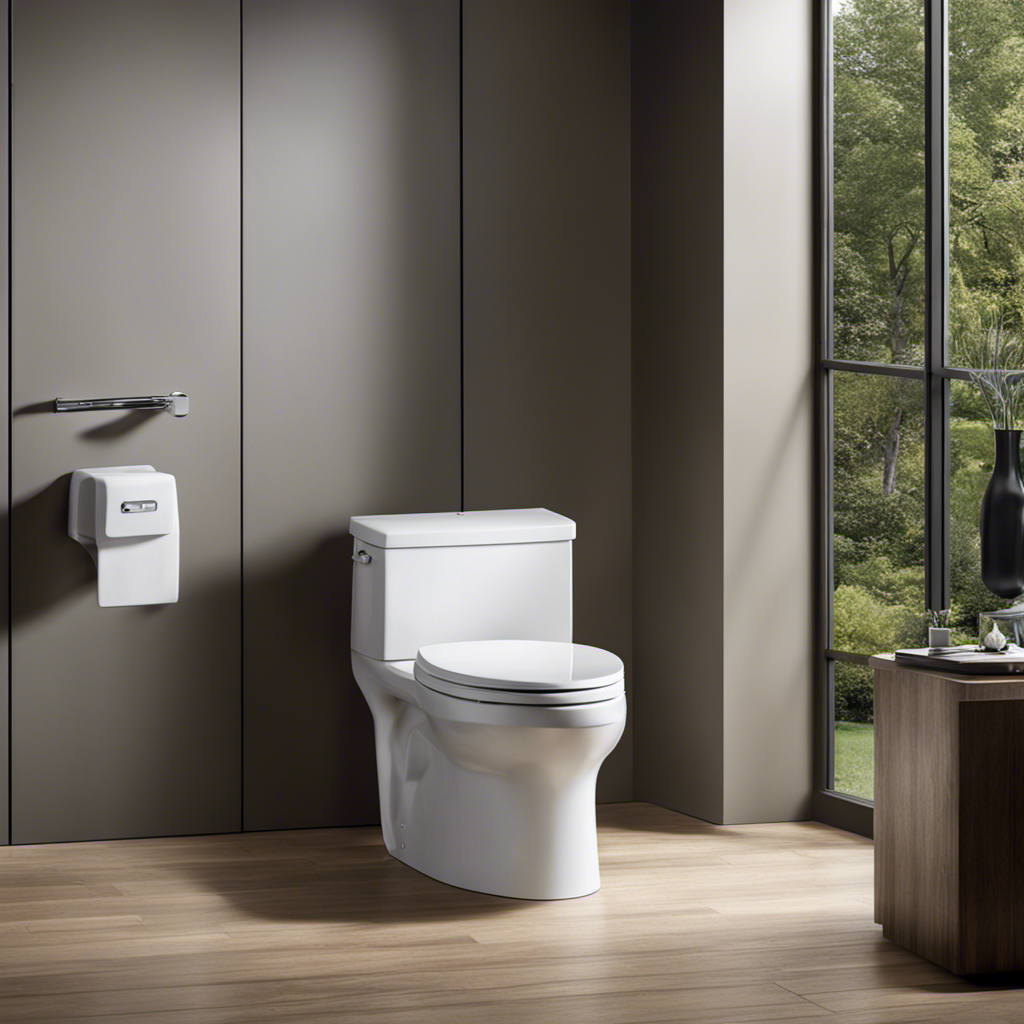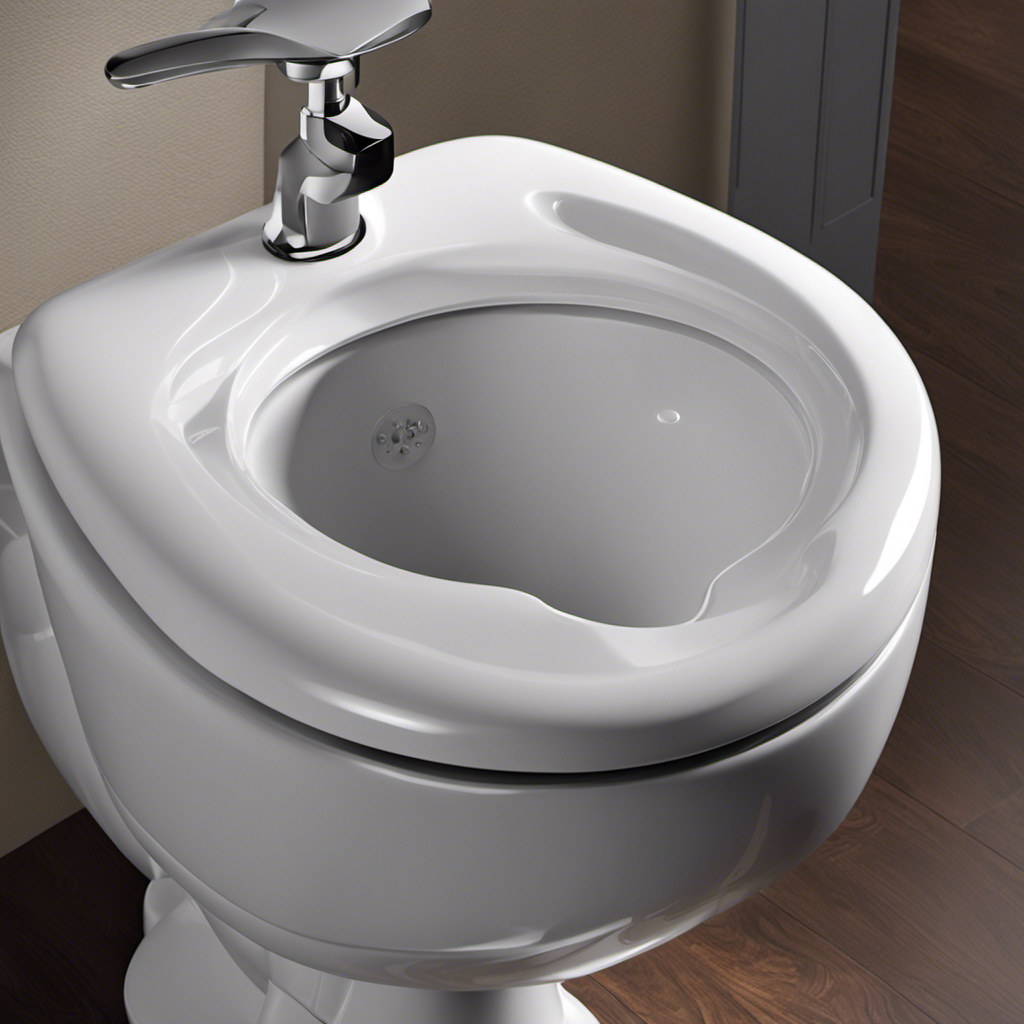As someone who’s been in the bathroom remodeling business for years, I can confidently say that understanding what an ADA compliant toilet is can make a world of difference.
So, let’s dive in, shall we? In this article, I’ll walk you through the history of ADA compliance in toilets, the key requirements for an ADA compliant toilet, and the benefits of using one. Plus, I’ll share some common features to look out for and give you tips on how to choose the right ADA compliant toilet for your specific needs.
Let’s get started!
Key Takeaways
- ADA compliance in toilets ensures accessibility for individuals with disabilities.
- Key requirements for ADA compliant toilets include seat height, clear floor space, and grab bars.
- ADA compliant toilets provide increased accessibility, comfort, and safety for all users.
- Choosing the right ADA compliant toilet involves considering factors such as seat material, height, and personal preferences.
History of ADA Compliance in Toilets
You’ll be surprised to learn that the history of ADA compliance in toilets dates back several decades.
The impact of ADA compliance on toilets has been immense, as it has revolutionized the way we design and use these essential fixtures.
The Americans with Disabilities Act (ADA), enacted in 1990, set guidelines to ensure accessibility for individuals with disabilities. These guidelines included specific requirements for toilets, such as grab bars, seat height, and clear floor space, to accommodate wheelchair users and those with mobility impairments.
Over the years, these regulations have greatly improved the accessibility and comfort of toilets for all individuals.
Looking towards the future, ADA compliance will continue to play a crucial role in toilet design, as new technologies and innovations emerge to further enhance accessibility and inclusivity.
Key Requirements for ADA Compliant Toilets
When installing an ADA compliant toilet, it’s important to meet key requirements to ensure accessibility for all individuals.
Following accessibility guidelines and plumbing standards is crucial in creating an inclusive and safe environment.
To comply with ADA regulations, the height of the toilet seat should be between 17 and 19 inches above the finished floor.
Additionally, the toilet must have a clear floor space of at least 60 inches in diameter and grab bars on both sides for support.
The flush controls should be located on the open side of the toilet and require minimal effort to operate.
Benefits of Using an ADA Compliant Toilet
To fully understand the advantages of using an ADA compliant toilet, it’s important to consider the increased accessibility and comfort it provides.
ADA compliant toilets are designed to meet specific requirements that make them accessible for individuals with disabilities. One of the key advantages is the increased accessibility. These toilets are designed with features like grab bars, raised seats, and larger spaces to accommodate people with mobility challenges. This ensures that everyone, regardless of their physical abilities, can use the toilet safely and independently.
Another advantage is the added comfort. ADA compliant toilets are designed with ergonomic features that provide a more comfortable and convenient experience for all users.
These toilets are not only beneficial for individuals with disabilities but also for the general population, as they promote inclusivity and equal access for everyone.
Therefore, the importance of using an ADA compliant toilet cannot be overstated.
Common Features of ADA Compliant Toilets
One of the common features found in ADA compliant toilets is the presence of grab bars for added support and safety. These grab bars are strategically placed around the toilet to assist individuals with mobility challenges in sitting down and standing up.
In addition to grab bars, ADA compliant toilets also incorporate other design elements to enhance toilet accessibility. These include:
-
Height-adjustable toilets: ADA compliant toilets are designed to have a seat height between 17 and 19 inches, making it easier for people with disabilities or limited mobility to use the toilet comfortably.
-
Wide doors and entryways: ADA compliant toilets typically have wider doors and entryways to accommodate individuals who use wheelchairs or other mobility aids.
-
Clear floor space: ADA regulations require a clear floor space of at least 60 inches in diameter to allow wheelchair users to maneuver easily within the toilet area.
-
Lever-style flush controls: Instead of traditional flush handles, ADA compliant toilets often feature lever-style flush controls, which are easier to operate for individuals with limited hand strength or dexterity.
How to Choose the Right ADA Compliant Toilet for Your Needs
It’s important to consider your specific needs when choosing the right ADA toilet for you. One of the key factors to consider is the toilet seat. Look for a seat that is comfortable, durable, and easy to clean. There are a variety of materials to choose from, such as plastic, wood, or cushioned seats.
Another important consideration is the toilet height. ADA compliant toilets typically have a higher seat height, usually around 17-19 inches, to make it easier for individuals with mobility challenges to sit down and stand up. This higher height can greatly improve accessibility and reduce strain on the knees and back.
Frequently Asked Questions
Can I Install an ADA Compliant Toilet in My Home?
Yes, I can install an ADA compliant toilet in my home. It offers numerous benefits such as easier access for individuals with disabilities and the option to install grab bars for added safety.
What Is the Maximum Height Requirement for an ADA Compliant Toilet Seat?
The maximum height requirement for an ADA compliant toilet seat is determined by the Americans with Disabilities Act (ADA) guidelines. These guidelines ensure that the toilet seat is accessible and comfortable for individuals with disabilities.
Are There Any Specific Brands That Offer a Wide Range of ADA Compliant Toilets?
Yes, there are several brands that offer a wide range of ADA compliant toilets. These toilets are designed to meet the specific requirements of bathroom remodeling for accessibility and offer many benefits for users with disabilities.
Can a Regular Toilet Be Modified to Meet ADA Compliance Standards?
Yes, a regular toilet can be modified to meet ADA compliance standards. There are specific modifications that can be made, such as installing grab bars and adjusting the height, to make a regular toilet ADA compliant for public restrooms.
Are There Any Specific Guidelines for Installing Grab Bars Near an ADA Compliant Toilet?
When installing grab bars near an ADA compliant toilet, it is important to follow specific guidelines. These guidelines ensure the safety and accessibility of the toilet for individuals with disabilities. Having an ADA compliant toilet provides numerous benefits, including improved accessibility and comfort.
Conclusion
In conclusion, choosing an ADA compliant toilet is not just a matter of convenience, but also a matter of inclusivity and accessibility.
These toilets have evolved over time to meet the needs of individuals with disabilities, ensuring that everyone can use the restroom safely and comfortably.
By adhering to the key requirements and common features of ADA compliant toilets, you can make a thoughtful choice that benefits both yourself and others.
So, don’t hesitate to ‘kill two birds with one stone’ and invest in an ADA compliant toilet for your bathroom.










